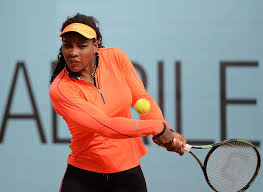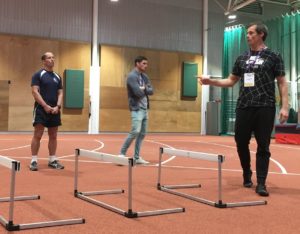Main Menu
Latest Blog Entry
User login
IFAC Reflections Part 2
A review of Jerome Simian’s workshops on physical preparation for sport.
I had to choose between different “strands” of coaching topics at the IFAC conference in Loughborough. A difficult choice, not wanting to miss out on some excellent speakers. I chose to attend Simian’s because of a quote I heard on the HMMR podcast:
“I have an obligation to results, not an obligation to methods.”
This resonates with me as I wanted to hear from someone who has to get results from the athletes he works with, or he won’t get paid. He has “skin in the game.” This is different from someone who is promoting a model on paper, in print or to a captive audience.
I was all ears and ready to learn from someone I had never met before.
I shall give an overview of Simian’s theoretical approach, plus details on his practical applications and my experiences as guinea pig in several of them.
Fundamental Physical Preparation: A Systematic Approach
“The best ones have the strongest fundamentals.”

Simian recounted watching Serena Williams warm up. She hit between 80-120 shots just leaning into her backhand. Her excellence may be related to her persistence that allows her to then dictate what the ball does.
This fundamental approach guides Simian. Athletes usually come to train with him because they have a problem to solve. He receives no funding from a Governing Body, so he has to find a solution to help the athlete that hasn’t been found in their usual training.
“Will the environment you provide be stronger than the environment they came from?”
I like this concept: if we aren’t increasing the stimulus, how will the athlete adapt and get better?
Simian then quoted Michel Pradel:
“The aim of physical preparation is to go beyond the level of motor ability that can be achieved by the sole practice of the chosen activity.”
General to Specific Exercises
Linking back to what Martin Bingisser had talked about in the previous hour, Simian highlighted exercises from two different events from General to Specific (see below).

Figure 1 100m General to Specific

Figure 2 Women’s discus General to Specific
If you look at how this is set out, take a moment to reflect on the importance of “traditional resistance training”. A lot of heat and noise comes out of journals, social media and conferences, but very little light.
Simian then says he uses a system of thinking, rather than specific methods. This allows him a framework within which he can choose different methods (exercises, drills, outside sources) that help him to adapt to different athletes and their needs.
He did give an overview of different periodisation models and why he uses Zatiorsky’s adaptation model. In a nutshell, it is about managing fatigue better, so the athlete is better prepared at the end of the workout or day to then train again.
He uses a Heart Rate Variability app with his athletes as he has found that was the simplest and most effective measure of fatigue. It was the best marker of the Parasympathetic nervous system that is linked to overall stress.
But, I think this part of the seminar was of less relevance than his system of training.
General Physical Preparation Planning Principles (GPPPP?)
Simian says that he doesn’t create an athlete specific programme immediately. Instead “there are certain things every athlete ought to be able to do.”
Each athlete goes through the system to start, this then allows Simian to gain a better understanding of how they move, what limiting factors there might be, and also what makes the athlete tick.

This graphic shows the progression of thought. Looking at what the limiting factors might be, training in core athletic activities, then some specialisation according to the sport (the context).
Then comes strengthening of the fundamentals and sport specific factors. Finally another look at what any limiting factors might be.
A systematic hunt of the limiting factor and its improvement
This seemed to be the crux of Simian’s approach (as discovered in the practicals).
“Muscles have to handle each other around the joint. An injury in one may mean the loss of control, or too early a deceleration in a throw”.
The art for Simian was to find out where the muscles were lacking, and then find a solution to improve it. He then gave examples of throwing actions and how injuries to different parts affected the overall throw.
One thing I took from this on muscle activation:
- Acceleration/ take offs- muscles activate from proximal to distal (centre to limbs).
- Deceleration/ landings: the reverse, so distal to proximal (feet, ankles, knees to hips).
Simian was very good at comparing the athletics throws and how they differ due to the different rotations. More rotations allow a longer path of acceleration, with hammer throwers rotating over 40 metres.
In his work with Kevin Mayer (Decathlon World record holder) Simian has done a great job of analysing the movements, the events and joining the two together. The level of detail and understanding was impressive.
Practical workshops: Observation, analysis, application
Now to the practicals: looking at assessment of athletes and potential solutions.

With a group of over 20 coaches, Simian had a young volunteer take part in the practicals to be assessed. I was lucky enough to be pushed forward by Martin Bingisser and so ended up taking part too. This was a mixed blessing.
The review to follow is therefore from the perspective of a participant, rather than a passenger.
Now to the practicals: looking at assessment of athletes and potential solutions.
Practical workshops: observation, analysis, application
Simian used the hurdles picture to assess our ability to do repeated rebounds over them. He gains information from this to then ascribe/prescribe further exercises in the gym. LC and I did this several times each.
(N.B. At no point in these workshops did Simian ever demonstrate; it took a lot of time and explanation to get things right. I got tired repeating the exercises, many of which were either new, or not something I practise regularly. Information taken from my stumbling efforts was tainted with lack of skill.
As a coach are you assuming deficit of strength (imbalances) when really skill is deficient? It is easy to jump to conclusions.)
Simian’s feedback to LC was that her back was collapsing during the rebounds, so more strength type supplemental work was needed.
His feedback to me was that more springing practice was needed, so doing the hurdles exercise will help me get better. Strength didn’t appear to be the issue.
Back strengthening exercises

We then spent the next hour in the gym with LC as the subject, looking at back strengthening progressions. They were as follows:
- Assessing LC in the Roman Chair– showed tightness around T12 which leads to poor rotation (problematic for a thrower). Simian then pressed down on her lumbar spine and got her to extend. This isolated the thoracic spine (T Spine) to enable more movement.
- In order to get a contraction in the T Spine, he tried to get a relaxation in the rectus abdominus. He rubbed LC’s tummy as a cue and then said “relax that”. Her movement improved, so he changed her position on the chair so she had more flexion at the beginning.
- Once the movement was correct and the range had increased, he added a light barbell to her shoulders. LC had to hold for 6 seconds, then slowly lower down again.
- The key point was to only extend the spine after hip extension. All sports (except golf) require this sequence, rather than spine extension followed by hip extension.
Sprinters who pop up too soon may have weaker spines. It is easy to hold the spine erect upright than in horizontal.
The next series of exercises were off the Roman Chair and progressed as follows:
- Good Mornings- LC was still hinging at T12, so a lighter load was needed. The maximal load was being taken at T12, rather than across the spine.
- Hip Hinge with barbell in front (Romanian Dead Lift, RDL). Trying to extend the spine throughout the whole movement.
These exercises help athletes keep an upright chest when running without a pelvic tilt. If the pelvis anteriorly rotates when the chest is high, it creates too much “backside mechanics” leading to over striding.
- Snatch grip deadlift– hips and shoulders rise together. If the hips rise first, it shows too early a knee extension. The extension should be: hips-knee-ankles in that order.
- Feet elevated snatch deadlift- harder to control. Slow up for 5 seconds, then down for 5 seconds.
At no point was “Lift Heavy” used as a cue. The progressions were greater range of motions with greater technical difficulty. “The lighter weight I can use to get an effect, the better.”
Simian said that once LC had got competent in these exercises then he would progress her through greater speed and exercises such as pulls and snatch that encourage that speed.
“If to do an exercise properly, you have to solve the same problem that you do on the track, then it’s probably a good exercise.”
Here was where Simian was excellent– he knew what the problem in the event was, and then used exercises to help isolate certain parts of that event and improve them. Problem solving and skilful movement by the athlete were essential parts of the process.
Part 3 will look at Leg strengthening progressions in the gym.
Client Testimonials
 University of Exeter
University of Exeter
James has been our lead strength and conditioning coach for the Talented Athlete Scholarship Scheme (TASS) at the University of Exeter since the scheme's inception. His attitude, professionalism and above all his drive and desire to help each sportsman and woman develop and reach their potential is exactly what we require. James shows a real interest in each of his athletes and helps them to aspire to be as good as they can and ensures that no goals are unattainable.
More


Comments
Hmm it seems like your website ate my first comment (it was super long) so I guess I’ll
just sum it up what I submitted and say, I’m thoroughly enjoying
your blog. I as well am an aspiring blog writer but I’m still new
to everything. Do you have any points for inexperienced blog writers?
I’d certainly appreciate it.
Hi,
thanks for your comments. Write about what you know and love, be nice, proof read everything.